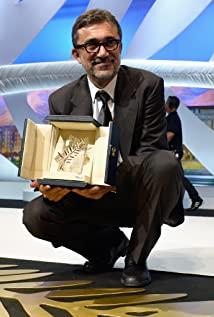At the beginning of the film, Yousef slowly appeared on the scene from a wide open lowland. The picture began to be crowded. Then the camera swayed to the left of the road out of the town, helping him complete the ceremony of rebelling against his hometown. However, the symbol of "Distant" (the one The direction of the road) Behind the camera, an urban disenchantment is foretelled. In this nearly three-minute long shot, the part that left appeared quickly and anchored in the change of Yusuf's position. Let's be more careful. Lens designs with similar meanings are everywhere in the distance. After the film was unveiled, Mahmut's appearance-the foreground is half of his face panting, and the background is a defocused girl undressing. Then, in the dialogue scene between Mahmut and his ex-wife, the opposite is true-half of his face is blurred in the foreground, and his ex-wife expecting a miracle in the background is clear; in the home part, Mahmut is almost always lying on the red sofa, while Uther The husband walked back and forth around the sofa. It was not until the third act that Yousef sat on this red sofa for the first time. The position of the camera also came to the back of the sofa, a surveillance perspective; especially The scenes of Cerf walking in the snowy streets, mostly slowly pulling away from the city and the crowd, and then walking to the camera, revealing his big face.
The vision in the film should not be a pure phenomenon, lying within a closed system, creating a disordered reading experience, and it is also known as returning to the image itself. To achieve universal excellence, let us return to the simple and classical dichotomy theory, that is, the so-called form and content should be relatively unified. Speaking of this, I have to mention a stunning landscape shot. The frame starts with a swaying anchor (almost as if it is hanging). A huge freighter lies on the snow-covered shore, and Yousef staggers away from behind. Entering the harbor cemetery in the painting, stopping in front of the freighter's body, he left in shock. Yousef, who wants to find a job as a sailor, must fail after passing this shot. In addition, this shot also proves that the movie is inseparable from the big screen, and the lofty distance can only be captured when the entire hull of the ship is stuck on the screen.
Regarding the appearance of the freighter, we can also trace it back to the opening of the film. When Yousef leaves the town and the scene ends, the screen is dark, and the sound of the ship sounded. Then in the darkness, the movie space began to drift from the town to Istanbul. After that, the movie would sound the same sound several times, like Wailing. What the freighter refers to is very clear. In contrast, Mahmut's middle-class spiritual crisis also has a sound appearance. Before Mahmut's debut, a distraught wind chime rang in the darkness, and after that, the same wind chime runs through the film, intertwining with the sound of the ship. The sound element was successfully incorporated into the image, and it was heard and seen. As the director and photographer, Ceylon was able to shape it into the narrative with ease.
The relationship between the characters in "The Far Place" is the core narrative area. Ceylon mostly uses the position or distance in the image (the relative position between people and camera, camera and space) to directly show the relationship between characters. After completing the character’s narrative task, the ambition of “image distance” did not end. It also refers to the extended social relationship and outlook behind the two individuals, such as economic storms, industrial ruin, class issues... On this point, the distance is not enough. The narrative behind the two individuals, including the troubles of Yusuf's hometown and Mahmut's terminal illness, seems to only serve the change in the relationship between the two of them. Of course, Ceylon in the period of "Distant" did not intend to focus on the social structure picture, and was more willing to rhetoric the humorous indoor play of a pair of cousins, which was the focus of the whole film.
When I watched "Distant" for the first time, I immediately remembered that in "Anna Karenina", Levin went to Moscow to find his brother Sergei Ivanovich for the first time. Vanovich is participating in a debate about human psychology and physiology with a philosophy professor. Levin, who loves farmers and land issues, seems out of place, but as part of Tolstoy’s projection, Levin has a strong sense of position. No matter what, sooner or later, he will intervene in this field to express his opinions, thus forming a "mini-square" in the novel. There is a similar scene in "Remote Place" that can be compared for comparison, which can wittily deconstruct the above scene of "Anna". Mahmut came to meet at a friend's house, and Yusuf looked around. These photographers and artist friends talked about "Takovsky", "Photography is dead", "Woman" and so on. He seemed bored. Contrary to "Anna", the "intellectual" role in "The Far Place" is Mahmut, who obviously has a projection of Ceylon's self. After the party was over, poor Yousef didn't vomit a word, and returned home and drove Mahmut downstairs, trying to get a woman to talk to him. Immediately afterwards, in the next scene, Yusuf was dismissed by Tarkovsky, and Mahmut replaced the TV with a raw film, which also vented the fire.
In the eyes of Ceylon, the metropolis carries "sexuality." The name "Ceylan" has just been blacked out in the film, and it is an erotic drama with no results; Yusuf, who first came to Istanbul, was attracted by the street girl who happened to meet on the roadside before he settled down, showing ugliness. As the film goes on, the appearance of women is the most obvious difference between the two protagonists, and the film also focuses on this. Please allow this description. Ceylon replaced "female" with an objectified "asset" to support the different class attributes of these cousins of the same blood. Yousef has been stalking young women for no gain, but the hormones are full. However, Mahmut, who has the so-called "sex" right to speak, is a panting situation of impotence even if he calls his female partner home. There is no discussion of patriarchy or patriarchy in Ceylon here. On the contrary, these two forms face an incomplete result regardless of their strength.
The last digression. There are only five people in the crew of "Distant", which is surprisingly small, but it is also inspiring to change thoughts. It provides a good reference for those who want to make independent films. In Istanbul with a Mediterranean climate, heavy snow is rare, but if you go to make a "movie", it will appear.
View more about Distant reviews









